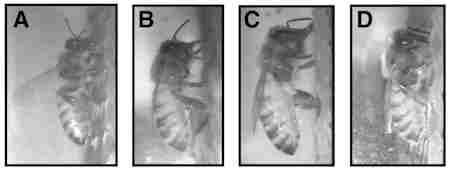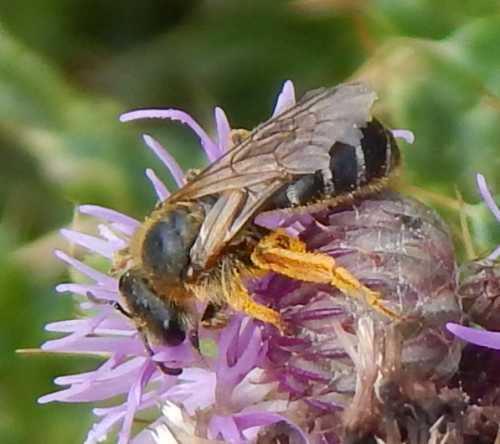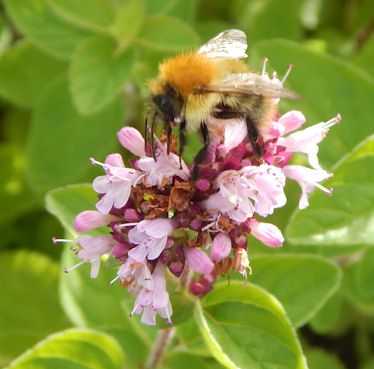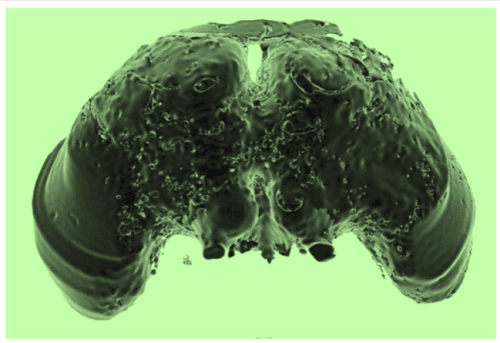Why Do Bees Buzz, And How?
The gentle sound of bees buzzing among the flowers in the garden has to be one of the loveliest sounds of summer. But why do bees buzz, and how do they make that
buzzing sound?
The short answer is:
Buzzing is caused by a rapid vibration of wing muscles, and may be used by bee species in different ways, for example: to loosen the pollen from a flower during buzz pollination, to regulate temperature in a nest or hive, or to communicate). Read on for further information about how and why bees buzz!
Why Do Bees Buzz And How Do Bees Make That Buzzing Sound?
Of course, we can't get into the minds of bees! But by observing their behaviours, we can make a few guesses, for example, when we listen and watch as bumble bees make a loud buzzing sound as they collect pollen from flowers.
Whilst investigating this question, I found that theories and ideas had changed over time. No surprise there: history shows we form ideas about a thing, only to learn more and change our minds later!
Back in 1912, a researcher called Sladen1 thought that the noise was caused by air passing over the edge of a membrane in tiny holes in the segments of the abdomen (body). These holes are called 'spiracles' (see 'Do Bees Have Lungs? / How Do Bes Breathe?).
More recently, it is suggested that the sound of bees buzzing is caused by the rapid movement and vibration of the wing muscles located in the thorax (upper body). The rapid contraction of the wing flight muscles is what causes the high-pitched whining (buzzing) sound.
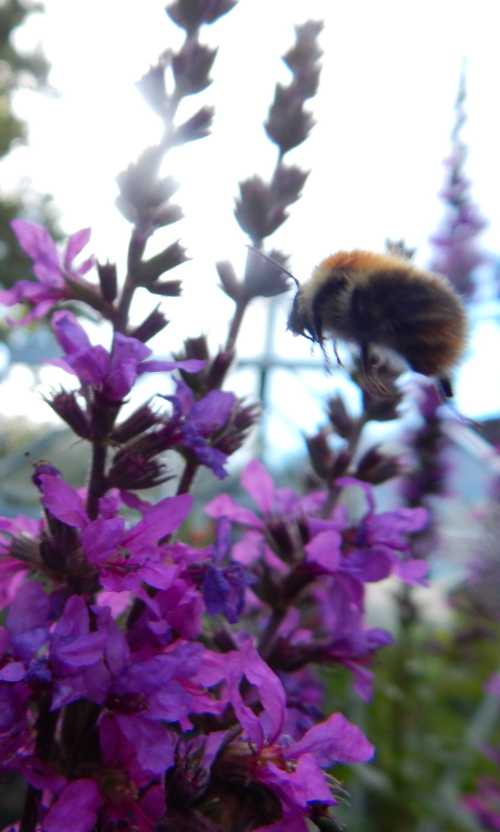 Common carder bumble bee (Bombus pascuorum) in flight toward purple loosestrife.
Common carder bumble bee (Bombus pascuorum) in flight toward purple loosestrife.When Do Bees Buzz?
This vibration of wing muscles and the resulting buzzing sound, occurs during various activities, and interestingly, not only during flight.
Here are 5 examples of when bees buzz:
1. Buzzing During flight
Firstly, buzzing is of course, commonly heard when bees are simply flying, during which time, the wing muscles are vibrating fast and working hard in the thorax to power the wings and generate 'lift' and flight for the the bee.
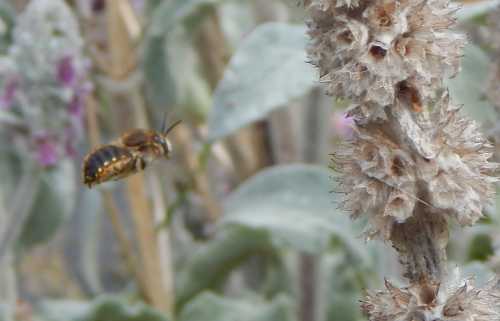 A wool carder bee (Anthidium manicatum) in flight
A wool carder bee (Anthidium manicatum) in flight
2. Whilst foraging
Some bee species produce a particularly loud buzz whilst foraging, especially during 'buzz pollination', commonly witnessed in bumble bees (Bombus) and some solitary species such as large carpenter bees (Xylocopa) and leafcutters (Megachile) but not honey bees (Apis species)2.
During buzz pollination (sonification), the muscles in the thorax are contracted very fast to produce a vibration that shakes the pollen grains from flower anthers, so that the bee can collect the pollen3.
Watch this short video below and listen to the distinct buzzing sound as a bumble bee uses sonification to collect pollen from a rose flower. Note the difference in buzzing tone as she flies away.
3. Temperature and air regulation
Bees may vibrate their wing muscles either for warming up or cooling down4. The vibration is accompanied by a buzzing sound.
4. Communication
Another example of wing muscles vibrating to produce a buzz sound without flying, occurs during communication. It can be used to exert dominance5, and to warn off predators and threats3.
One particular type of high-pitched buzzing sound made by honey bees is called 'piping'. Piping occurs directly prior to swarming6, but can also occur during the disturbance or defense of a colony7.
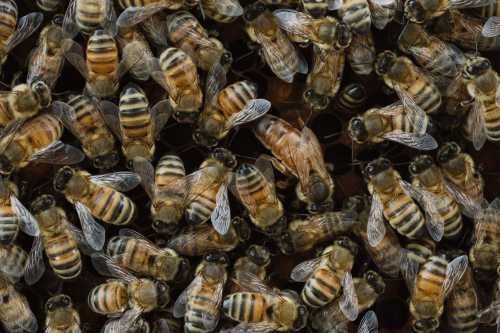 Honey bees communicate using various types of buzzing sounds.
Honey bees communicate using various types of buzzing sounds.5. Mating
Research suggests that buzzing may be a feature of the mating process at least in some species. This has been proposed for species such as the vernal mining bee (Colletes cuniculares) during the process of attracting a mate, and during the mating process itself, which may in part make the female more receptive to the male, and deter predators8.
Look out for buzzing bees!
Compare these different buzzing sounds and their flight movements as they forage on Pulmonaria:
A female hairy-footed flower bee:
A female carder bumble bee:
Next time you are out in the garden, listen out for the different buzzing sounds and pitches coming from the bees as they go about their business.
Observe:
- The different buzz pitch coming from various bee species.
- The different sounds coming from bee species as they pollinate flowers.
- The buzzing sounds coming from bumble bees of different sizes and species.
Do Bees Ever Buzz 'Angrily'?
Buzzing And Flight Power
I have personally witnessed a bee trapped in a spider web, apparently buzzing as it attempted to free itself.
Similarly, I have noted that bumble bees trapped in a bottle were buzzing loudly, seemingly using a pitch quite different from the relaxed hum I hear as they visit flowers in my garden.
In both scenarios, it was easy to simply interpret this behaviour as 'angry buzzing'.
From the research reports I have read to compose this article, it's clear that vibrating the flight muscles produces power, which in turn affects the tone and pitch of the buzz (which is of course affected by the physical characteristics of the bee2).
Could it be that the buzzing sound heard was simply the effect of bees trying in a practical way, to fly off from or escape from their entrapment?
Certainly, I have rescued bees from spider webs, and noted how the removal of webbing has coincided with wing flapping and buzzing, even with no spiders present.
References
1. See page about Sladen.
2. Tayal, M.; Kariyat, R. Examining the Role of Buzzing Time and Acoustics on Pollen Extraction of Solanum elaeagnifolium. Plants 2021, 10, 2592. https://doi.org/10.3390/ plants10122592
3. De Luca PA, Vallejo-Marı´n M. What’s the ‘buzz’ about? The ecology and evolutionary significance of buzz-pollination, Curr Opin Plant Biol (2013), http:// dx.doi.org/10.1016/j.pbi.2013.05.002
4. Read more and see references on my page about bee wings.
5. RICHARD M. FISHER & DANIEL M. WEARY (1988) BUZZING BEES: COMMUNICATION BETWEEN BUMBLE BEE SOCIAL PARASITES (HYMENOPTERA: APIDAE) AND THEIR HOSTS, Bioacoustics, 1:1, 3-12, DOI: 10.1080/09524622.1988.9753070
6. Seeley, T.D. and J. Tautz 2001. Worker piping in honey bee swarms and its role in preparing for liftoff. J. Comp. Physiol. A 187: 667-676.
7. Sen Sarma M, Fuchs S, Werber C, Tautz J. Worker piping triggers hissing for coordinated colony defence in the dwarf honeybee Apis florea. Zoology (Jena). 2002;105(3):215-23. doi: 10.1078/0944-2006-00064. PMID: 16351870.
8. LARSEN, O.N., GLEFFE, G. and TENGÖ, J. (1986), Vibration and sound communication in solitary bees and wasps. Physiological Entomology, 11: 287-296. https://doi.org/10.1111/j.1365-3032.1986.tb00416.x
Do bees sleep?
Apparently they do, but how do we know?
